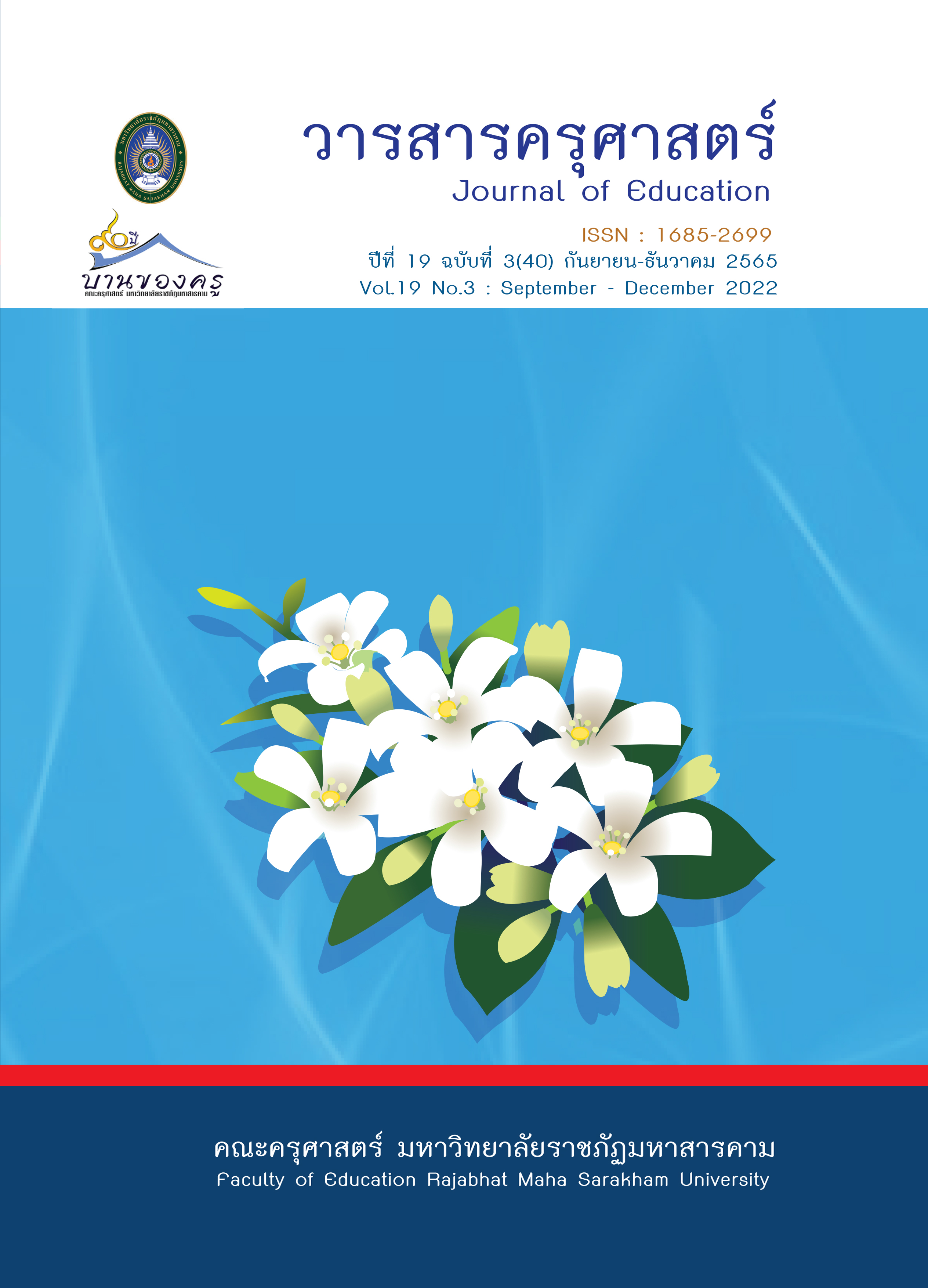The Enhancement of Creative Thinking by using Blended with Project-based Learning for Matthayom 1 Students at Ban Napho School (Sahaphan Pittayaporn)
Main Article Content
Abstract
The objectives of this research were ;1) to study the results of The Enhancement of Creative Thinking using Blended with Project-based Learning, 2) to study the creativity of students through Blended with Project-based Learning, 3) to study students’ satisfaction in Blended with Project-based Learning. It consists of 4 steps of action research which are planning, action, observation and reflection. The target group was 39 students in Matthayom 1 in the second semester of the academic year 2021 at Ban Napho School (Sahaphan Pittayaporn). The tools used for data collection were journal notes, behavior observation form, creative thinking test, management record form and satisfaction questionnaire. The data was analyzed using mean and standard deviation.
The results of the research were as follows: 1) The results of The Enhancement of Creative Thinking by using Blended with Project-based Learning consisted of 6 steps defined as: 1) interest stage, 2) problem determination stage, 3) planning stage, 4) implementation stage, 5) Conclusion and Presentation and 6) Assessment. Therefore, each step of learning management is a student-centered teaching that stimulates the interest of students, and leads to knowledge searching on their own. 2) The students had a mean total creativity of 50.14 and a standard deviation of 2.00. 3) The students had a high level of satisfaction with the learning management at a mean of 3.61 and a standard deviation of 0.88.
Article Details

This work is licensed under a Creative Commons Attribution-NonCommercial-NoDerivatives 4.0 International License.
ข้อกำหนดเบื้องต้นที่ผู้นิพนธ์(ผู้ส่งบทความ) ควรทราบ
1. ผู้นิพนธ์ที่ประสงค์จะลงตีพิมพ์บทความกับวารสาร ตั้งแต่เดือนมกราคม 2563 เป็นต้นไป ให้ใช้รูปแบบใหม่ (Template 2563) โดยสามารถดูตัวอย่างได้ที่เมนู GUIDELINES
2. จะตีพิมพ์และเผยแพร่ได้ ต้องผ่านการประเมินจากผู้ทรงคุณวุฒิ (Peer Review)
3. การประเมินบทความโดยผู้ทรงคุณวุฒิ (Peer Review) เป็นแบบ Double Blind
4. การอ้างอิงบทความใช้หลักเกณฑ์ APA (American Psychological Association) คลิก
5. บทความถูกปฏิเสธการตีพิมพ์ ไม่ผ่านการประเมิน ผู้นิพนธ์ขอยกเลิกเองหรือชำระเงินก่อนได้รับการอนุมัติ ทางวารสารไม่มีนโยบายการคืนเงิน
References
กระทรวงศึกษาธิการ. (2544). หลักสูตรการศึกษาขั้นพื้นฐาน พุทธศักราช 2544. กระทรวงศึกษาธิการ.
กระทรวงศึกษาธิการ. (2553). หลักสูตรแกนกลางการศึกษาขั้นพื้นฐาน พุทธศักราช 2551(พิมพ์ครั้งที่ 3).
โรงพิมพ์ชุมนุม สหกรณ์การเกษตรแห่งประเทศไทย.จำกัด.
กระทรวงศึกษาธิการ. (2562). นโยบายและจุดเน้นการจัดการศึกษาของกระทรวงศึกษาธิการ ปีงบประมาณ 2562.
http://www.reo2.moe.go.th/home/images/book/2562-PlanInspect2562.pdf
ขจรพงษ์ ร่วมแก้ว. (2559). การพัฒนารูปแบบการเรียนรู้แบบเปิดตามแนวคิดคอนเน็คติวิสต์ซึม เพื่อส่งเสริมการคิดสร้างสรรค์สำหรับนักศึกษาระดับปริญญาตรี [วิทยานิพนธ์ปริญญาดุษฎีบัณฑิตไม่ได้ตีพิมพ์].
มหาวิทยาลัยราชภัฏมหาสารคาม.
ไพศาล วรคำ. (2558). การวิจัยทางการศึกษา (พิมพ์ครั้งที่ 7). ตักสิลาการพิมพ์.
วิจารณ์ พานิช. (2555). วิถีสร้างการเรียนรู้เพื่อศิษย์ในศตวรรษที่ 21. มูลนิธิสดศรี-สฤษดิ์วงศ์.
ศิริพล แสนบุญส่ง. (2560). การพัฒนารูปแบบการจัดการเรียนรู้ห้องเรียนกลับด้านโดยใช้เทคโนโลยีคลาวด์
ที่มีผลต่อผลสัมฤทธิ์ทางการเรียนรายวิชาคอมพิวเตอร์สำหรับครูของนักศึกษาปริญญาตรี,
วารสารบัณฑิตศึกษา มหาวิทยาลัยราชภัฏวไลยอลงกรณ์ ในพระบรมราชูปถัมภ์ (11), 133-146.
สุมาลี ชัยเจริญ และคณะ. (2554). การพัฒนากระบวนการสร้างความรู้ของผู้เรียนตามแนวทฤษฎี คอนสตรัคติวิสท์
Constructivism โดยความร่วมมือของครูและนักการศึกษา (รายงานการวิจัยขอนแก่น). ขอนแก่น:
มหาวิทยาลัยขอนแก่น.
มนต์ชัย เทียนทอง. (2554). การออกแบบและพัฒนาคอร์สแวร์สําหรับบทเรียนคอมพิวเตอร์ช่วยสอน.
พิมพ์ครั้งที่ 3. กรุ งเทพมหานครฯ:ศนูย์ผลิตตําราเรียนมหาวิทยาลัยเทคโนโลยีพระจอมเกล้าพระนครเหนือ.
เรวดี รัตนวิจิตร. (2555). การพฒันาความคิดสร้างสรรค์รายวิชาคอมพิวเตอร์กลุ่มสาระการเรียนรู้การงาน
อาชีพและเทคโนโลยี โดยใช้การจัดการเรียนรู้แบบโครงงานเป็นฐาน สำหรับนักเรียนชั้นประถมศึกษาปีที่5. วิทยานิพนธ์ ค.ม. จันทบุรี: มหาวิทยาลัยราชภัฏรำไพพรรณี.
อภิชาติ อนุกูลเวช. (2555). การเรียนรู้แบบผสมผสาน. http://www.chontech.ac.th
Bonk, C.J., & Graham, C.R. (2004). Handbook of blended learning: global perspectives. San Francisco, CA:
Pfeiffer publishing.
Jellen, G. and K. Urban. (1989).Test for Creative Thinking Drawing Production. The Creative Child and Adult
Quarterly, 11(8), 107-155.
Kemmis, S & McTaggart, R. (1988). The Action Research Planer (3rd ed.). Victoria : Deakin University
Koh, W. K. (1991). An Empirical Validation of the Theory of Transformational Leadership in Secondary
in Singapore. Ph.D. Dissertation University of Oregon. Dissertation Abstracts
International. 52(2): 602-A.
Torrance, E. P. (1962). Guiding Creative Talent. Englewood Cliffs. NJ: Prentice-Hall, Inc.


